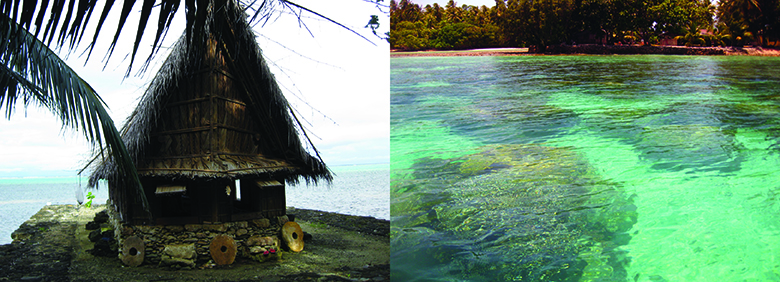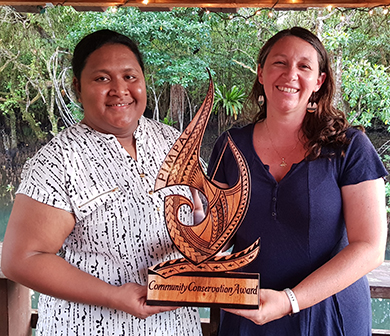- ABOUT US
- PROGRAM AREAS
- CONSERVATION APPROACH
- EDUCATION
- MULTIMEDIA
- PIMPAC capacity-building activities will continue to advance regional and state and territorial-level conservation initiatives such as the Micronesia Challenge, Guam Green Growth, Protected Area Networks, and the Hawaii Sustainable Initiative, aligned with the UN Environment Programme's Convention on Biological Diversity targets and Sustainable Development Goals.
- PIMPAC will emphasize the capacity for management effectiveness to support these goals and help ensure that networks of protected areas are effectively managed and able to achieve conservation and socio-economic results.
Strategic Planning for Protected Area Capacity-building and Conservation in the Pacific
By: Mike Lameier (CRCP) and Kristine Bucchianeri (NMFS)
Takeaway: Strategic planning advances capacity building, conservation, and a sense of community across the Pacific.
The Pacific Islands Managed and Protected Area Community (PIMPAC) is a long-term capacity-building program and a community of managers collaborating to enhance protected area management in partnership with local communities in the Pacific. It was created in 2005 and provides capacity-building opportunities to community members and government and non-government staff from Hawaii, Guam, CNMI, American Samoa, Palau, the Federated States of Micronesia, and the Marshall Islands.

Strategic plans have always successfully guided PIMPAC's approach to capacity-building and maintained PIMPAC's sense of community among its members. In early February 2023, after an almost three-year hiatus of in-person meetings and capacity-building activities driven by COVID-19 travel restrictions, partners convened in Pohnpei to create PIMPAC's fifth strategic plan.
Activities kicked off with a team-building activity where participants were divided into teams tasked with translating the following Pohnpeian phrase
Kitail kak wia soahng koaros oh e pahn pweida ahpw koaros anahne sawas pene!
(We can accomplish anything successfully through collective effort!)
Each team's access to translation materials and knowledge varied to remind participants that PIMPAC partners' access to knowledge and resources varies across the region, reinforcing the importance of collaboration and support. The next day covered a review of the results of the Evaluation of PIMPAC, which demonstrated that PIMPAC capacity-building activities have contributed significantly to conservation efforts. This helped partners orient themselves with past accomplishments, gaps, and recommendations for improvements. Over the next few days, participants drafted the vision, goals, activities, and monitoring plan that includes success indicators. These plan components were then used to develop a Theory of Change.


The outputs of the PIMPAC strategic planning meeting included the following:
During the closing ceremony, the Pohnpei Local Marine Managed Area Network Executive Committee was awarded PIMPAC's Community Conservation Award. The award recognized the hard work of the Pohnpei communities who are actively partnering with state government agencies to manage and protect their marine resources and share their lessons with one another. Recent monitoring data demonstrated their efforts are making an impact by improving fish populations. The award came with a USD1,000 small grant from the Micronesia Conservation Trust (MCT) to support future cross-site visit activities. About the award winners, Willy Kostka, Executive Director of MCT, noted, "Conservation is not something that happens overnight. But with diligence and consistency, the Pohnpei LMMA Network has shown that hard work pays."
About Us

The NOAA Coral Reef Conservation Program was established in 2000 by the Coral Reef Conservation Act. Headquartered in Silver Spring, Maryland, the program is part of NOAA's Office for Coastal Management.

The Coral Reef Information System (CoRIS) is the program's information portal that provides access to NOAA coral reef data and products.
Work With US
U.S. Coral Reef Task Force
Funding Opportunities
Employment
Fellowship Program
Contracting Assistance
Graphic Identifier
Featured Stories Archive

Access the archive of featured stories here...
Feedback
Thank you for visiting NOAA’s Coral Reef Conservation Program online. Please take our website satisfaction survey. We welcome your ideas, comments, and feedback. Questions? Email coralreef@noaa.gov.
Stay Connected
Contact Us
NOAA’s Coral Reef Conservation Program
SSMC4, 10th Floor
1305 East West Highway
Silver Spring, MD 20910
coralreef@noaa.gov
